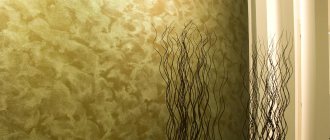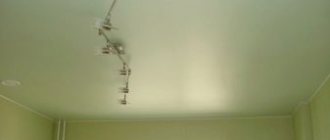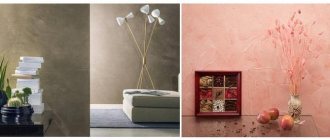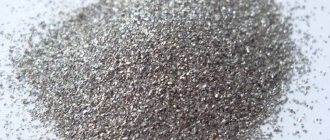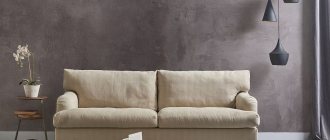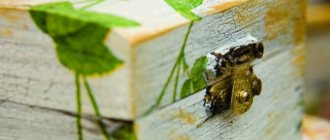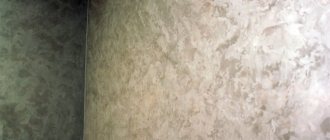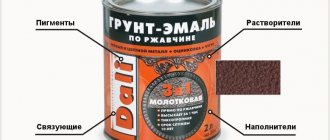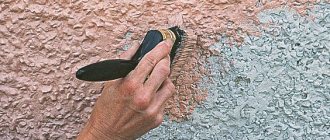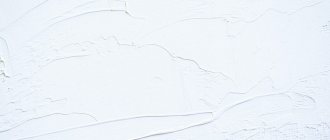The decorative effect of the coating is directly dependent on the prepared surface and the painting method. Wall decor paint can work wonders. With its help you can create an imitation of wood, silky or velvet surface.
Decorative wall paints allow you to create a unique look for your home. Manufacturers offer a choice of decorative paints with the effect of silk, with the effect of sand, with the effect of velvet, marble, granite, plaster, and precious metals (gold, silver).
Paints also come with the addition of mother-of-pearl, which results in a chameleon effect.
What is decorative wall paint and methods of applying it
Decorative paint is a paint that creates some visual effects. This group does not include ordinary opaque monochromatic compositions. Only those that are at least somewhat different from them. These compositions reproduce various natural materials. Silk, velvet, plush, sand, natural stone, leather, velor, etc. They are sometimes called decorative paints, since they are not just a background, but an independent decorative element.
Decorative wall paint with a silk effect is a decorative element in itself
Most often, decorative paint is applied as usual - with a brush, roller or spray gun. If the texture itself is “rich”, this is quite enough. The walls already look unusual. In this case, they are just background. Beautiful, unusual, stylish, but background.
Rollers with embossed relief - easy and simple way to get unusual wall decor
To obtain more interesting surfaces, special application techniques are used. The simplest ones are relief rollers. They break up the monotony of paint by adding relief. There are other methods too.
- The applied paint is rubbed off. So you can get wet silk or plush from “silk” paint.
- Partially wipe off the paint with crumpled paper, a sponge, a piece of fur, plastic or metal notched spatulas, metal wool, etc.
- They go over the top with a semi-dry roller or a hard brush with darker or lighter paint.
- Place plastic film on the painted piece, crumple it a little and remove it.
Some ways for creative design
In general, there are a lot of options.
This process is completely creative and there are a lot of variations. And the result can be very different, even if you use the same paint.
Preparing walls for decoration
In the case of finishing walls using decorative paints, for the first time it is necessary to properly treat the working area before painting. With this treatment, your work will be justified, as it will last reliably for many years.
Such preparation should take place in stages:
- First you need to clean the old coating.
- Prime the walls.
- If necessary, repair any damage to the work surface.
- Large uneven areas must be filled with putty.
- Then you need to reapply the primer ball.
After completing all the above steps, the surface is ready for the main work. It should be noted: in order for it to stay on the wall for a long time and reliably, you need to let the plaster and primer dry completely, and then start decorating the working surface.
Decor paint effects
As already said, decorative paint for walls reproduces certain textures of natural materials. In this case, they often talk about paint “with effect”. For example, with the effect of silk, sand, stone, leather, etc. There are many options and variations, and you can get lost in specialized catalogs. It will be a little easier if you have an idea of what you can find and what it might look like.
- Antique, patina.
- Silk, silk threads.
- Velvet and velor.
- Sandy surface.
Accent wall. This is where you can decorate it with decorative paint with an “effect” - Under decorative plaster.
- Nacre.
- Metallic.
- Leather, suede.
- With the effect of natural stone.
As you can see, the list alone is impressive. And different paints will give the same effect differently. This is due to the fact that the components and fillers differ. And the difference is sometimes significant. In general, it is usually difficult to decide. But know that whatever you choose will be interesting.
Alkyd and oil paints
Alkyd paints contain alkyd resin. It increases the resistance of the coating to mechanical stress. This paint can be used for rooms with sudden changes in temperature and humidity.
This type of painting material has a bright, rich color. But it has an equally pronounced unpleasant odor, which makes repair work difficult. If you breathe in the fumes of this paint for a long time, you will harm your health. So we recommend using alkyd paints only for exterior decoration or in a very well-ventilated area.
Oil paints contain natural ingredients, the main one being drying oil. This coating is safe for health. It is excellent for treating building facades because it withstands moisture and low temperatures well.
Compared to painting materials made from other components, oil paints are inexpensive. But the low price is accompanied by low quality. Oil paint smells unpleasant, the coating often cracks and bubbles, and due to drying oil, the color of the walls turns a little yellow over time.
So it is better to take oil paints for external finishing work. If you take it for interior, get ready to update the color in the room in 7 years.
Cans of alkyd and oil paints sell out quickly, so the benefit from purchasing such material will not be that high.
Why are decorative paints better than others?
Modern decorative paints can’t even be compared with oil paints of the Soviet period and ordinary water-based emulsions, because they are better for many reasons:
- With their help, you can imitate a wall like natural stone, gilding, silk fabric or other texture, and also come up with your own original relief.
- Decorative paints are easy to apply to prepared surfaces in several layers.
- All types of decorative wall paints withstand direct sunlight and do not fade for many years.
- Such coatings are resistant to external mechanical influences. Most of them can be washed with water.
- Decorative paints have high vapor permeability, therefore, a favorable level of moisture will be maintained in the room.
What are their disadvantages?
Like any type of finishing material, paints have their drawbacks:
- Paint, unlike wallpaper, does not provide additional noise and heat insulation.
- Before painting, you need to carefully treat the wall. Any unevenness, crack or chip will not be completely covered by paint, so before decorative work you need to prime and putty the wall.
- Buying high-quality decorative paint at a low price is difficult.
Decorative paint for walls with the effect of silk and silk threads
Many manufacturers have wall paint that looks like silk. If there are at least several decorative or interior paints, then one of them is silk. The look is very sophisticated and delicate. Suitable for living rooms, bedrooms. In terms of performance (acrylic can be washed with a brush), it can also be used in the hallway, but if you are satisfied with such a “refined” look of your hallway.
When choosing, pay attention to the base. Security is important for housing. The best option is silk-effect paint based on aqueous acrylic dispersion. It is relatively inexpensive (when compared with silicone, for example), washable, does not fade and can be painted in all colors. Many decorative paints are made on this basis. To obtain paint with a silk effect, a special type of mother-of-pearl and pigment are added to it.
This is what interior silk paint looks like on a wall
Paint consumption is average, you will have to paint in at least two layers. This is for low absorbency or pre-priming. The absorbent surface will require three coats exactly. And paint is not cheap, so it’s better to prime it. If the paint is based on acrylic dispersion, then we use acrylic primer. But it's better from the same company as the paint. There will be no problems with product compatibility.
The disadvantage is that the surface to be painted must be flat. Almost perfectly flat. The second point is that if you want to get “exclusive”, you need to master the application technique. You can, of course, just roll it out with a roller. It will work out well too. But it could be more interesting.
You can wash it with detergent (not abrasive), a rag or a brush. This cleaning does not affect the appearance. In the sense that it is not getting worse. Where the walls are frequently touched, “glossy” areas may remain. If you want this type of finish in your hallway, consider a varnish finish. But this type of paint “breathes”, so if you varnish it, you will lose this effect.
Each company that produces silk-effect decorative paint has a slightly different appearance. Some have multiple options. And not colors, but textures
If you think that silk effect paint looks the same from all manufacturers, you are mistaken. They use different additives, resulting in slightly different surfaces. This type of decorative paint is popular, so some have several paints that give different textures. There are also different application techniques. With their help, you can get different types of surfaces: classic, wet and crushed silk.
What is better: decorative plaster or paint?
People who decide to transform their walls and ceilings with modern textured coatings immediately ask themselves the question, which is better - paint or plaster compositions?
We answer. Despite the fact that both are designed to create additional texture and volume in the interior, they have some differences. In general, we can say that decorative paint is a “lightweight” version of plaster.
We do not always require heavy textures, so for such cases, light coloring compositions are optimal. Let's look at this using the example of finishing a metal wall.
Metal look wall
If you require a “metallic” texture, texture paint is perfect for you. It will create iridescence characteristic of a metal surface, give the surface a characteristic golden or silver shine and, in general, will look like metal.
Metal wall in the interior
But if you need to provide a high relief with an imitation of peeling rust or a reinforced concrete wall with chipped pieces, then, of course, in this case it is more rational to turn your attention to plasters.
However, modern decorative painting solutions based on high-density latex, liquid plastic or rubber (especially with the inclusion of granules, stone, mineral or pearl chips, flocks) can provide such a coating thickness that allows them to be classified as plasters. The line between these products is quite thin, and sometimes completely absent.
Differences from plaster
The purpose, structure and composition of color and plaster are similar. The difference usually lies only in the dispersion of the coloring material. The color scheme has a finer structure, while plaster compositions often have larger inclusions, which make it possible to achieve a more noticeable relief.
Coatings of this type also differ from traditional paints and varnishes in that they are used only for purely aesthetic purposes - the finishing of walls is usually done on top of an already leveled or primed surface.
Among the most obvious differences from plaster, perhaps, we can highlight a few more:
- The drying speed is several times higher than that of plaster mortars. This is due, first of all, to the thickness of the paint layer.
- The consumption of decorative paint per m2 ranges from 100-150 to 300 milliliters per square meter (2-3 times lower than that of plaster mixtures, which require up to 400-500 milliliters per meter. Depending on the density, translated into grams - this is 600-900 g).
- Dust resistance - many color compositions today include antistatic agents that can effectively repel dust particles, remaining clean for a long time. Most are also moisture resistant.
Among the disadvantages are low heat and noise insulation.
Coating
Sand or sand dune effect on walls
The composition of sand-effect paint includes binders, solvents, antiseptics, and crystal dispersions. When applied, we get shimmer, and after drying the texture appears. With different application techniques we get different looks - dunes, dunes, sandy overflows.
The effect of sand and sand dunes is created using special decorative wall paint
The paint is easy to apply and no special techniques are required. Due to the pronounced texture, minor wall defects are hidden. So the requirements for the surface are not so stringent.
Application and operation
The paint is easy to apply; no complicated techniques are required. Unless you want to have not just “sand”, but dunes. But to create such an effect, special compounds are required.
It is not possible to wash sand effect paint with a brush. Gentle cleaning with soft attachments on the vacuum cleaner. And keep in mind that if you touch a wall painted with sand effect paint, the relief will crumble. But this is invisible and does not affect the appearance. The surface is initially heterogeneous, the relief simply changes slightly. The view does not suffer from this. The service life is up to 10 years, which is not bad at all for paint.
Please note the availability of hygiene certificates for this type of paint. The binder is not always harmless. So having certification and a certificate from the sanitary inspectorate about the amount of substances released is simply necessary.
Structural paint with sand for decorative plaster
This type of coating is similar to decorative plaster. But the paint has a more liquid consistency, so it is applied in a thin layer with a roller or brush, and sometimes spatulas are used. But this is not necessary, and they are also used to obtain relief on the surface. Structural paints with sand are based on an acrylic water dispersion with fillers of various sizes.
Structural paint for interior work gives a surface that is similar to decorative plaster
Paint with the effect of decorative plaster can be painted in bulk; the base color is white. It can be used in a single-color version, but it is possible to make a two-tone coating. To do this, apply structural paint as a base. After it has dried, paint of a darker or lighter tone is applied with a semi-dry roller or brush. It can be matte, glossy or with some effect. There are options. The so-called “glaze” is obtained.
Rules for selecting and calculating paint volume
Since decorative paint is not cheap at all, you need to correctly calculate the expected consumption. Therefore, remember a few basic rules.
Before starting work, measure the height and length of the walls, taking into account the sizes of door and window openings (they are subtracted from the total value). Then move on to choosing paint. As a rule, manufacturers write on the cans the approximate consumption of material per square meter.
Keep in mind that you will spend more paint if the decorative plaster has a deep and complex relief.
When choosing paint, look for the highest material consumption values for your room and multiply them by two. You need to multiply because you will be painting in several layers.
Don't forget to take into account unforeseen situations. To do this, when purchasing decorative paint, add another 10-15% to the total volume of the can.
Here are some more tips for choosing the right paint for a given situation:
- If you are going to decorate a bathroom or the facade of a house with paint, make sure that it contains antifungal substances.
- The paint should adhere well to the base of the plaster and/or wall. Therefore, look for compounds with high adhesion (this is a parameter that determines the strength of paint adhesion to another material).
- Choose a moisture-resistant compound because it will withstand dry abrasion better. Moisture-resistant materials can withstand up to 5,000 cleanings, while conventional materials can only withstand 1,000.
- Matte compositions better mask wall defects. Glossy ones increase the volume of space.
Velvet and velor - the next effects
The reproduction of velor and velvet surfaces is quite reliable. Paints with the effect of velor and velvet (Projekt 04 - Project 04) are made on the basis of acrylic water dispersion, adding particles to it, which create the effect of a fleecy surface. The walls themselves remain smooth. To obtain an evenly painted surface, it is recommended to apply with a spray gun. If you like “crushed” velvet and velor, you can use a brush or roller.
Paints with velor effect - muted shine and apparent velvety
Walls painted with velor effect wash well, do not fade for a long time and do not change their appearance. They can only become shiny from frequent touching. Therefore, it is better to use them for residential premises, not for corridors and kitchens.
Decorative paint for walls with mother-of-pearl: application features
Paint with a pearlescent effect is usually made based on an acrylic water-soluble copolymer. This means it is safe. The light, unique shine of mother-of-pearl cannot be confused with anything.
The main thing is application technique
And if you want “gold” or “silver” wall paint, but not provocative, then you will most likely like pearlescent paint in a suitable shade. Another option is silk. Slightly different look, more subdued shine. But you need to see it all. Even in the photo you can't show the difference.
Colors and additives
There are enough shades and colors of decorative paint with a mother-of-pearl effect. They usually sell a concentrate that is diluted with water. For one part of concentrate take 6-8 parts of water. The intensity of the shine depends on the amount of water.
If you add microfibers, you can hide wall defects
Flocks and glitters can also be added to the base composition - white or colored inclusions, small fibers, sand, multi-colored crystals, sparkles. Candis and San Marco have such options. There are also varnishes with mother of pearl. They can be used to coat base paint and create an abrasion-resistant pearlescent surface.
Application Features
But working with pearlescent paint is not easy. It is especially difficult to obtain a uniform pearlescent sheen over the entire surface. This is not an easy task. Even the masters can’t handle everything, and it’s better not to try it yourself. You will only waste an expensive product.
But if you want to get pearlescent stripes, waves, stains - no questions asked. True, you need to practice first, since the application technique greatly affects the appearance. The tool used to apply the pearlescent paint also has an effect. Some types are applied in one layer, others in two. Read the description.
Those that are applied in two layers do not mean “bad”. They give you more options. The first one can be considered basic. It creates the background. But the second is to draw the relief. You can use a roller with a structured “coat,” a spatula, or brushes with bristles of varying hardness. In general, there are many options. But you will need to reproduce all the movements almost exactly. So it takes training. Or a good master. But also ask him to show a sample in a small area, and only then agree or not.
This paint can be applied as a second layer to the structural one. If you use a translucent one, you can only get a slight lightening of the color in the texture and a characteristic shine. Or you can go a few shades darker/lighter or, in general, apply paint of a different color with light strokes.
Tips for using decorative paint
So, to achieve the desired effect on the wall, you need to follow the painting rules.
Of course, different colors and effects will have their own characteristics, but among the general rules,
experts highlight the following
:
- Prime the wall before painting. This will not only level the surface, but also protect against the formation of fungi and mold. The main thing is to wait until the primer layer has completely dried and only then apply paint.
- Before finishing work, protect the floor, window sills and ceiling from drops. If, for example, you accidentally stain them with acrylic paint, it will be very difficult to get rid of the drops later. In addition, the paint dries quickly. Therefore, for protection, lay down newspapers or buy special film material. It will definitely not allow the paint to bleed through, unlike regular paper.
- Before opening the jar, shake it slightly or stir the liquid after opening. During the work process, you also need to periodically stir the composition so that sediment does not accumulate at the bottom.
- If you are using a roller and/or brush, apply strokes horizontally and vertically. So, the paint is first applied horizontally, and then shaded with vertical movements. You can do it the other way around: first vertically, then horizontally. This technique will help distribute the paint evenly on the wall.
- If you use a roller, be sure to remove any remaining paint using the sanded edge of the container. This will prevent paint particles from getting on you, your clothes and other nearby objects. Using a roller, strokes are applied from top to bottom and vice versa, with an overlap of about 40-50 millimeters.
- It is best to work with both a brush and a roller. First, apply decorative paint with a brush, blend it, and then even out the shade with an additional layer using a roller.
- Using a sponge you can shade the decorative surface. It will give the wall an antique effect.
- If you want to achieve an unusual result, paint the wall in two layers of different paints. The first layer (base) is always light, and the second (base color) is darker. We recommend that you first select a future pattern or design, which will then appear in contrast.
Conclusion
So, before you buy decorative paint, look at the composition of the product. It must be suitable for the conditions of the room. So, for the bathroom it is better to take water-based paint. And an alkyd composition is perfect for finishing the facade of a building.
Our online store Valles.ru presents various compositions with a matte or glossy effect. The price of decorative paint starts from 180 rubles/m2. To make it easier for you to make a choice, we have attached photographs with the color of the painting material and all the necessary characteristics on the page under the photo. We wish you a pleasant shopping experience!
Stone effect paint
Another decorative paint, in appearance very similar to decorative plaster. This is a stone effect paint. It is safe as it is made on the basis of acrylic emulsion. Decorative elements are added to it, which create the required appearance and relief. For example, Rust Oleum Multispec Stone Accents, Siberia Rock`n`Wall. This paint has 10 shades - from very light to quite bright. Can even be used in kitchens on work aprons.
Both natural stone effect paints look about the same
A very good specimen in terms of performance properties. Has very good adhesion. Very smooth surfaces - such as plastic - require a primer. The rest can be painted immediately. It is applied from a spray gun or using a special roller (from the same company). Appearance depends on the method of application. After the roller, a surface with clearly defined flakes of “stone” remains. After the spray gun the surface is smoother.
This stone-imitating paint is easy to use and durable. It can even be washed with a brush. For Rust Oleum, application of additional protection (in the form of varnish) is not required, but in areas of heavy pollution it is better to coat Siberia with varnish. The paint is repairable. If you get a bald spot or a chip somewhere, you need to moisten a piece of sponge with water, squeeze it out and dip it in the paint, apply it to the desired place and wait until it dries.
There are also stone paints in cans. But you are unlikely to use them to paint walls. Perhaps for a panel or some kind of decoration. It's too expensive.
This is what the stone paint “Alatyr stone” looks like
Another type of surface is provided by paint with the effect of burnt stone Alatyr-stone. It is also called “liquid granite”. Apply by spraying through a spray gun. There are single-color and multi-color options. Less shiny than the ones described above. Positioned as resistant to cracks and ultraviolet radiation. After drying it must be varnished.
Decorative paint for walls in the interior: photo
Seeing what effect paint looks like on a piece of cardboard or on a screen is one thing. But imagining how it will look in the interior is completely different. To make the task easier, we have collected several photos of interesting interior solutions. As a recommendation: if you are going to cover all the walls, look towards very light shades. Bright and dark ones are used to decorate accents. These are accent walls, dedicated zones. In general, see for yourself.
Through one color another “shines through” - one of the techniques
And some people call gray color boring. We need to play him right
Bright color - only on one wall. It is also repeated in some small details or has a companion color. In this case, the second option is chosen - floor color
Different application techniques give different looks. Here we use chaotic movements with a narrow spatula on a freshly painted surface
This is the result of rolling with a relief roller. Non-standard
The effect of cracked old paint. Very interesting, but requires an appropriate interior
Ordered chaos. This can be called the principle of drawing these lines
Triple effect: silk, two colors and stripes
This can be done from paint with mother-of-pearl, silk effect or velvet/velor, metallic
